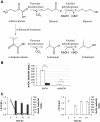A novel pathway to produce butanol and isobutanol in Saccharomyces cerevisiae
- PMID: 23642236
- PMCID: PMC3662618
- DOI: 10.1186/1754-6834-6-68
A novel pathway to produce butanol and isobutanol in Saccharomyces cerevisiae
Abstract
Background: The sustainable production of biofuels remains one of the major issues of the upcoming years. Among the number of most desirable molecules to be produced, butanol and isobutanol deserve a prominent place. They have superior liquid-fuel features in respect to ethanol. Particularly, butanol has similar properties to gasoline and thus it has the potential to be used as a substitute for gasoline in currently running engines. Clostridia are recognized as natural and good butanol producers and are employed in the industrial-scale production of solvents. Due to their complex metabolic characteristics and to the difficulty of performing genetic manipulations, in recent years the Clostridia butanol pathway was expressed in other microorganisms such as Escherichia coli and Saccharomyces cerevisiae, but in yeast the obtained results were not so promising. An alternative way for producing fusel alcohol is to exploit the degradation pathway of aminoacids released from protein hydrolysis, where proteins derive from exhausted microbial biomasses at the end of the fermentation processes.
Results: It is known that wine yeasts can, at the end of the fermentation process, accumulate fusel alcohols, and butanol is among them. Despite it was quite obvious to correlate said production with aminoacid degradation, a putative native pathway was never proposed. Starting from literature data and combining information about different organisms, here we demonstrate how glycine can be the substrate for butanol and isobutanol production, individuating at least one gene encoding for the necessary activities leading to butanol accumulation. During a kinetic of growth using glycine as substrate, butanol and isobutanol accumulate in the medium up to 92 and 58 mg/L, respectively.
Conclusions: Here for the first time we demonstrate an alternative metabolic pathway for butanol and isobutanol production in the yeast S. cerevisiae, using glycine as a substrate. Doors are now opened for a number of optimizations, also considering that starting from an aminoacid mixture as a side stream process, a fusel alcohol blend can be generated.
Figures







Similar articles
-
Butanol production by Saccharomyces cerevisiae: perspectives, strategies and challenges.World J Microbiol Biotechnol. 2020 Mar 9;36(3):48. doi: 10.1007/s11274-020-02828-z. World J Microbiol Biotechnol. 2020. PMID: 32152786 Review.
-
Xylose utilization stimulates mitochondrial production of isobutanol and 2-methyl-1-butanol in Saccharomyces cerevisiae.Biotechnol Biofuels. 2019 Sep 20;12:223. doi: 10.1186/s13068-019-1560-2. eCollection 2019. Biotechnol Biofuels. 2019. PMID: 31548865 Free PMC article.
-
Butanol production from renewable biomass: rediscovery of metabolic pathways and metabolic engineering.Biotechnol J. 2012 Feb;7(2):186-98. doi: 10.1002/biot.201100059. Epub 2011 Aug 5. Biotechnol J. 2012. PMID: 21818859 Review.
-
Analysis of metabolite profiles of Saccharomyces cerevisiae strains suitable for butanol production.FEMS Microbiol Lett. 2019 Jul 1;366(13):fnz164. doi: 10.1093/femsle/fnz164. FEMS Microbiol Lett. 2019. PMID: 31350996
-
Butanol production in S. cerevisiae via a synthetic ABE pathway is enhanced by specific metabolic engineering and butanol resistance.Biotechnol Biofuels. 2015 Jul 8;8:97. doi: 10.1186/s13068-015-0281-4. eCollection 2015. Biotechnol Biofuels. 2015. PMID: 26175798 Free PMC article.
Cited by
-
n-Butanol production in S. cerevisiae: co-ordinate use of endogenous and exogenous pathways.Appl Microbiol Biotechnol. 2018 Nov;102(22):9857-9866. doi: 10.1007/s00253-018-9305-x. Epub 2018 Sep 1. Appl Microbiol Biotechnol. 2018. PMID: 30171268 Free PMC article.
-
Exploration and mutagenesis of the germacrene A synthase from Solidago canadensis to enhance germacrene A production in E. coli.Synth Syst Biotechnol. 2025 Feb 28;10(2):620-628. doi: 10.1016/j.synbio.2025.02.015. eCollection 2025 Jun. Synth Syst Biotechnol. 2025. PMID: 40151792 Free PMC article.
-
Metabolic engineering of a synergistic pathway for n-butanol production in Saccharomyces cerevisiae.Sci Rep. 2016 May 10;6:25675. doi: 10.1038/srep25675. Sci Rep. 2016. PMID: 27161023 Free PMC article.
-
Genetic resources for advanced biofuel production described with the Gene Ontology.Front Microbiol. 2014 Oct 10;5:528. doi: 10.3389/fmicb.2014.00528. eCollection 2014. Front Microbiol. 2014. PMID: 25346727 Free PMC article. Review.
-
Techno-economic assessment for the production of algal fuels and value-added products: opportunities for high-protein microalgae conversion.Biotechnol Biofuels Bioprod. 2022 Jan 18;15(1):8. doi: 10.1186/s13068-021-02098-3. Biotechnol Biofuels Bioprod. 2022. PMID: 35418157 Free PMC article.
References
LinkOut - more resources
Full Text Sources
Other Literature Sources
Molecular Biology Databases

